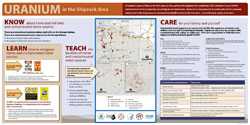ATSDR Stories from the Field
 Health Communication and Education Specialists and Scientists at the Agency for Toxic Substances and Disease Registry (ATSDR) work around the clock to educate and keep you safe from harmful substances in the air you breathe, the water you drink, and the soil under your feet.
Health Communication and Education Specialists and Scientists at the Agency for Toxic Substances and Disease Registry (ATSDR) work around the clock to educate and keep you safe from harmful substances in the air you breathe, the water you drink, and the soil under your feet.
1 in 4 people in the U.S. lives within 4 miles of a hazardous waste site. With staff in Atlanta as well as 10 regional offices and 25 state health departments across the country, ATSDR is available 24/7 to respond to local concerns and protect health during environmental emergencies like chemical spills and natural disasters.
Stories from the Field
ATSDR Division of Toxicology and Human Health Services (DTHHS) Environmental Health Surveillance Branch (EHSB) — Assessment of Chemical Exposure (ACE) Investigation: Methyl Bromide Release at a Condominium Resort—U.S. Virgin Islands

ATSDR investigates hazardous exposure at tourist destination in the Caribbean.
On March 20, 2015 a family of four vacationing in a condominium resort in the U.S. Virgin Islands (USVI) developed progressively worsening neurological symptoms, including weakness, severe tremors, and confusion, over a period of several hours. The U.S. Virgin Islands Department of Health (VIDOH) discovered that methyl bromide, a highly toxic pesticide, had been inappropriately used by a pest control company to fumigate the condominium unit below the one the family had been occupying. The family members were initially hospitalized in USVI and soon transferred to hospitals in Delaware and Pennsylvania for further treatment.
ATSDR was initially contacted by the U.S. Environmental Protection Agency (EPA) to provide medical consultation for the ill patients, and subsequently, in April, by VIDOH to investigate the incident. An Assessment of Chemical Exposure (ACE) team was dispatched in response to the request.
The ACE team included staff from the ACE program, ATSDR Region 2 office, Division of Community Health Investigations OD, and CDC Epidemic Intelligence Service (EIS). They collaborated with the ATSDR Emergency Response Program and the NCEH/ATSDR Office of Communication in Atlanta on the investigation.
They learned that methyl bromide had been used by the same pest control company at the same resort in October 2014 as well as the March fumigation. In addition to the family that fell ill, 37 more people were identified who might have been exposed to methyl bromide as a result of the October 2014 and March 2015 fumigations. Of 20 people for whom contact information was available, 16 were interviewed with a standardized health questionnaire. Six respondents reported post-exposure symptoms, including headache and fatigue.
The ACE team apprised the VIDOH of their initial findings to inform agency decisions about further public health actions.
To learn more about the ACE Program, visit Incident Investigations.
ATSDR maps Navajo Nation uranium mines to protect people from excessive uranium exposure. View the poster.
ATSDR Division of Community Health Investigations (DCHI) Works with Partners to Protect Health – Uranium Awareness Training Course Empowers over 90 Navajo Community Health Representatives
For much of the U.S. population, uranium exposure stays at low levels. But in the 1940s, federal surveyors found large deposits of uranium on the lands of the Navajo Nation, which covers 27,000 square miles in New Mexico, Arizona, and Utah. In fact, from 1944 to 1986, uranium mines on Navajo lands yielded almost four million tons of uranium ore.
The mines have been closed for close to 30 years. But with over 500 abandoned uranium mine areas on their lands, Navajo Nation community members are concerned about possible exposure to uranium by direct contact with soil and rock or by using water sources containing uranium. They want to know the location of those mines and water sources, many of which have not yet been marked. And they need to know how to protect themselves and their families from possible uranium exposure.
To meet these needs, a team of representatives from the Agency for Toxic Substances and Disease Registry (ATSDR), the U.S. Environmental Protection Agency (EPA), and the Navajo Area Indian Health Service (IHS) developed posters to display across the Navajo Nation. These posters feature nine different maps showing the locations of mines and contaminated water sources and provide information about how to avoid exposure and maintain good health. The team delivered the one-day training course in Window Rock, capital of the Navajo Nation to help Community Health Representatives understand the new uranium awareness posters and fact sheets and learn how to use them to communicate with community residents.

ATSDR provides materials to keep staff and students safe from mercury spills at school.
New ATSDR Products
New Mercury Materials for Teachers
Three new interactive lesson plans for middle school teachers are now available on the “Don’t Mess with Mercury” website. The lesson plans, which are based on Next Generation Science Standards and Common Core Language Arts Standards for grades 6-8, provide teachers with tools necessary to educate students about the dangers of mercury and keep them safe. Mercury can be found in many common products in schools and school science labs. If spilled, mercury may cause serious health problems. Check out the Don’t Mess with Mercury website for additional tips, tools, and fact sheets.
Don’t Trespass
Each year thousands of people, including kids, put themselves at risk for coming in contact with numerous chemical and physical hazards by trespassing on old or abandoned facilities/sites. The No Trespassing PSA and website is aimed at kids and their parents with the message that these types of sites are not safe places to play. The ads will run in schools on Channel One and as ads on YouTube. For more information, visit the No Trespassing website.

- Page last reviewed: November 16, 2015
- Page last updated: November 16, 2015
- Content source:
- Agency for Toxic Substances and Disease Registry, Division of Community Health Investigations
- Page maintained by: Office of the Associate Director for Communication, Digital Media Branch, Division of Public Affairs




 ShareCompartir
ShareCompartir
